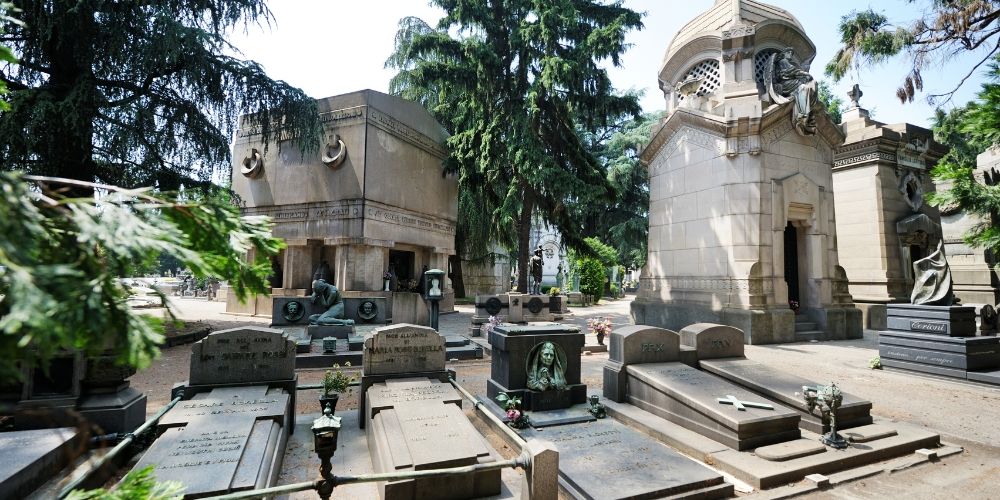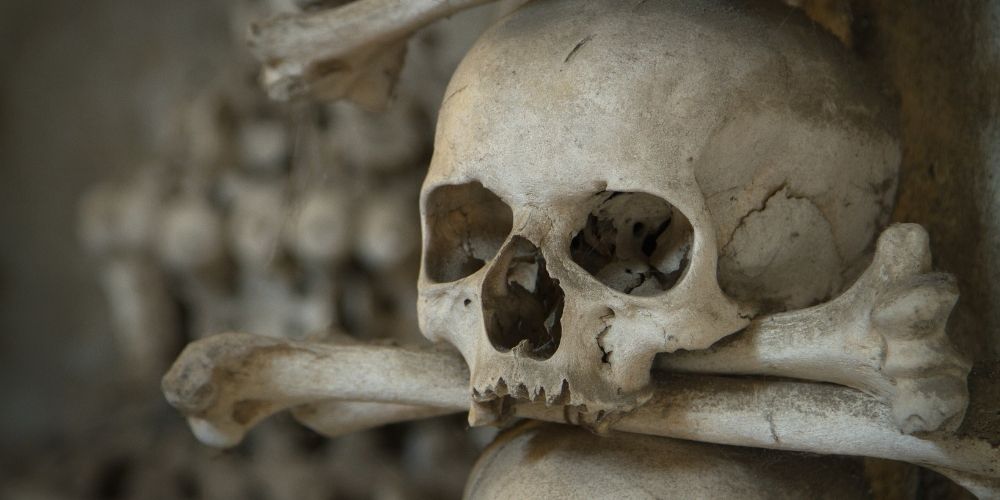A new kind of tourism is catching on in recent years: visiting Monumental Cemeteries, ancient burial grounds where time is suspended and one breathes tranquility, silence and peace.
Italy, being a country of art and history par excellence, offers Monumental Cemeteries worth visiting, in which it is possible to admire important funerary sculptures, tombs and noble chapels or humble and anonymous tombstones, where prominent people who have made history rest.
Without being frightened by beliefs and superstitions, we at Visititaly take you on a tour of some of the evocative Monumental Cemeteries in Milan, Genoa and Rome without neglecting the smaller but no less fascinating ones in Brescia, Venice, Bologna, Livorno and Naples.

Burial from Origins to Monumental Cemeteries

Burial in history, before Monumental Cemeteries.
The practice of burying the dead ones originated in antiquity, and every civilization has its own traditions and rituals around the mystery of death.
Since prehistoric times people were buried to preserve their memory, and the oldest remains of burials that have come down to us are the Necropolises i.e. 'cities of the dead'.
For fear of persecution, early Christians were buried in the Catacombs, underground tunnels excavated in the late 2nd and early 3rd centuries CE of which important examples are preserved today and can be visited.
When, in the 4th century AD, Constantine granted freedom of worship to Christians, the burial of the dead also changed.
In medieval times the custom of burying the dead in churches became widespread so that the bodies would be close to the relics of saints and martyrs and receive a kind of blessing. Class differences were reflected in the manner of burial: clergymen and wealthy class figures were buried under the floor, closer to the altars that held the remains of saints, other bodies around the church. In the same period the custom of decorating the tomb with a symbol - the anchor, the dove with olive branch, the lamb, the fish, the shuttle - an inscription, a portrait took hold to remove the faithful from anonymity.
By the Edict of Saint Cloud in 1804 Napoleon banned burial in churches and ordered the construction of cemeteries outside the urban circle: thus the cemetery was bornas we understand it today, a place designated for the burial of the dead in an architecturally defined space.
Cities that were the scene of important historical events, wealthy cities or those that were the birthplaces of illustrious men or families often host a Monumental Cemetery.
In Monumental Cemeteries, the layout is characterized by symmetry and balance of parts and, in many cases, feature rich vegetation that creates very striking effects. The burials have architectural features that draw on the different art-historical styles between the 19th and 20th centuries, and create a decent place to honor and celebrate the cult of remembrance of the artists, politicians, scientists and benefactors buried there.
5. The Monumental Cemetery of Milan

The Monumental Cemetery of Milan
The Monumental Cemetery of Milan was established in 1866 and is among the most important ones in Italy and Europe because of its architecture and the very high artistic value of the sculptures it contains.
At the center of the cemetery's front elevation is the Famedio, or "Temple of Fame" intended as a place for the burial, celebration and remembrance of Milanese people of origin or adoption who contributed to the city and Italy glory: the "illustri" citizens who elevated themselves for literary, artistic, scientific merits or distinguished deeds; the "well-deserving" ones, who by their own virtues have brought benefit and fame to the city; and the "distinguished in the history of their country" ones, who have contributed to national evolution, e.g., Arturo Toscanini, Giuseppe Verdi, Alessandro Manzoni, Dario Fo and Franca Rame, Carla Fracci to name but a few.
The wonderful works of art that adorn the tombs are by important artists such as Lucio Fontana, Medardo Rosso, and Giò Pomodoro. The chapels are also true works of art, designed by important names in the world of Milanese and decorated with fine sculptures and architecture.
The Municipality of Milan organizes free guided tours to promote and enhance the Monumental Cemetery, considered at the European level as a real "Open-air Museum" for its historical character and the artistic value of the works and illustrious people who have linked their names to the history of Milan and Italy.
Visit Milan with Milan Pass4. The Monumental Cemetery in Staglieno, Genova

The Monumental Cemetery in Staglieno, Genova
The Monumental Cemetery in Staglieno, Genoa, was officially opened on January 1st, 1851 although it was still unfinished.
It was designed by architects Carlo Barabino and Giovanni Battista Resasco and is a veritable open-air museum because of its architecture and large quantity of funerary artworks, so much so that Ernest Hemingway called it 'one of the wonders of the world' and many historical figures such as Friedrich Nietzsche, Guy de Maupassant and Mark Twain speak of Staglieno's charm and fascination in their writings.
The entrance to the Monumental Cemetery of Staglieno is flanked by the two statues of Hope and Charity and has a quadrangular structure. Over time, the original design was given a monumental character with the addition of wide porticos decorated by a double row of artistic monuments culminating in the imposing Pantheon, all harmoniously set within the natural surroundings, the Boschetto, in which rich family monuments stand.
The marble statues that adorn the tombs of Genoese nobles of the second half of the 19th century were created by important artists, and among the representative figures of history and culture who rest in this magical place are Giuseppe Mazzini, Constance Mary Lloyd wife of Oscar Wilde, and the great singer-songwriter Fabrizio De Andrè.
If you would like to participate in guided tours of the Cemetery, you can follow this link.
3. Verano Monumental Cemetery, Rome

Verano Monumental Cemetery, Rome
The Verano Cemetery was built between 1809 and 1812 to a design by Giuseppe Valadier and was consecrated in 1835.
The main entrance is made imposing by the presence of four large statues representing Meditation, Hope, Charity and Silence and precedes a large quadriporticus, the Carthusian Monastery, which houses private family burials.
Beyond the quadriporticus are vast fields sprinkled with crosses and scattered with cypresses and small monuments, the whole of which is of very picturesque effect.
The tomb monuments in Rome's Monumental Cemetery are characterized by a remarkable variety of styles ranging from Neoclassicism to Realism, from Eclecticism to Symbolism and Futurism, with works executed by the greatest exponents of nineteenth-century art.
Many prominent personalities are buried within its lofty walls, such as Alberto Sordi, Vittorio De Sica, Alberto Moravia, Trilussa, Giacomo Balla, Vittorio Gassman, Nino Manfredi, Gianni Rodari, Ettore Petrolini, Eduardo De Filippo and many others.
To admire the rich historical and artistic heritage of the Verano Monumental Cemetery, you can book a "Walks among Memories" visit, choosing from a variety of thematic tours such as those dedicated to the Great War, the Italian theater, or the important female figures who lived in the nineteenth and twentieth centuries who now rest in the Roman cemetery.
2. The Non-Catholic Cemetery for Foreigners, Rome
The Non-Catholic Cemetery for Foreigners in Rome is one of the oldest cemeteries in Europe and dates as far back as 1716; it came into being because the church did not allow non-Catholics to be buried within the city walls, which is why it is also called the English or Protestant Cemetery.
Because of the importance of the burials it houses it was declared a Monumental Area of National Interest in 1918.
It's an Anglo-Saxon-style cemetery with photo-less headstones and multilingual epitaphs, an enchanted place that instills a sense of peace in its visitors.
The Non-Catholic Cemetery for Foreigners unites men and women from different countries, languages and professions, and there are many prominent people buried here.
In fact, the Non-Catholic Cemetery is also called the Artists' and Poets' Cemetery; in fact, personalities such as John Keats and Percy Bysshe Shelley are buried there. Although it is a cemetery that hosts mainly foreign and particularly Anglo-Saxon non-Catholics, there are illustrious exceptions as in the case of Antonio Gramsci, Andrea Camilleri and, last in order of burial, Giorgio Napolitano 11th President of the Italian Republic.
Explore Rome with Visit Rome Pass1. Fontanelle Cemetery in the Rione Sanità, Naples

Fontanelle Cemetery in the Rione Sanità, Naples
An altogether peculiar cemetery, currently unfortunately not visitable, is the Fontanelle Cemetery in Naples, which holds the skulls and bones of Neapolitans who could not afford an official burial neatly placed in ancient quarries and crevices carved into the rock.
To this day it is still an object of veneration by Neapolitans and it seems that the ancient ritual of the "pezzentelle souls" is still practiced, meaning that each believer chooses the skull of an abandoned soul, the 'capuzzella' to care for in exchange for a pardon or more simply numbers to play the lotto.
After a long period of closure, finally in 2024 the Fontanelle Cemetery will reopen and be visitable again.
Visit Naples with Naples PassMore Monumental Cemeteries in Italy

More Monumental Cemeteries in Italy
There are still many Monumental Cemeteries from the North to the South of the peninsula that deserve a visit and where you can admire the burials and chapels beautifully decorated with striking sculptures dedicated to those who rest there. We suggest:
Vantiniano Monumental Cemetery, Brescia
This is the first monumental cemetery in the history of art and the oldest in Italy. It was the first to be designed by an architect who created not only a burial place that met the criteria of the Edict of Saint Clou but was a true monumental complex, with Neoclassical inspiration.
The Cemetery was designed by the young architect Rodolfo Vantini, nicknamed the Architect of Cemeteries.
Monumental Cemetery, Venice - Island of San Michele
This is a unique cemetery because it is located on an island and to reach it you have to take a vaporetto.
It was founded during the Austrian occupation to follow up the Edict of Saint Clou it was decided to allocate the small island of San Michele for exclusive use as a cemetery and funeral gondolas were introduced to transport the dead.
It is a multi-faith cemetery offering eternal home to Catholics, Evangelicals, Orthodox, and Israelites and where many famous people such as poet Ezra Pound and composer Stravinsky also rest.
Certosa Monumental Cemetery, Bologna
It was founded in 1801 on the structures of the former 14th-century Carthusian monastery.
Today it is counted among the largest in Italy and Europe and boasts a rich historical and artistic heritage, and it was equally successful as early as the 19th century, so much so that leading figures such as Lord Byron, Charles Dickens and Sigmund Freud came to visit it.
La Cigna Monumental Cemetery, Livorno
It is also called the Cemetery of 'The Wolves' because it stands on an ancient 3rd-century B.C. necropolis known to this day as "Santo Stefano ai Lupi."
The Cemetery was blessed on October 28, 1822, and contains valuable grave monuments by local sculptors and others.
It is a resting place for the deceased of various religious denominations and, next to family graves, houses the burials of fellow citizens who fell for their country or for the defense of Livorno.
About the author
Written on 01/11/2023




Mariateresa Bonanotte
Places of peace and memory filled with evocative sculptures and impressive chapels, Monumental Cemeteries are open-air museums. Discover them with us!